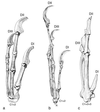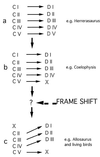1,2,3 = 2,3,4: a solution to the problem of the homology of the digits in the avian hand
- PMID: 10220427
- PMCID: PMC21825
- DOI: 10.1073/pnas.96.9.5111
1,2,3 = 2,3,4: a solution to the problem of the homology of the digits in the avian hand
Abstract
Persistent contradictions in well supported empirical findings usually point to important scientific problems and may even lead to exciting new insights. One of the most enduring problems in evolutionary biology is the apparent conflict between paleontological and embryological evidence regarding the homology of the digits in the avian hand (1, 2). We propose that this problem highlights an important feature of morphological change: namely, the possible dissociation between the developmental origin of a particular repeated element and its subsequent individualization into a fully functional character. We argue that, although comparative embryological evidence correctly identifies the homology of the primordial condensations in avians as CII, CIII, and CIV, subsequent anatomical differentiation reflects a frame shift in the developmental identities of the avian digit anlagen in later ontogeny such that CII becomes DI, CIII becomes DII, and CIV becomes DIII.
Figures






Comment in
-
1,2,3 = 2,3,4: accommodating the cladogram.Proc Natl Acad Sci U S A. 1999 Apr 27;96(9):4740-2. doi: 10.1073/pnas.96.9.4740. Proc Natl Acad Sci U S A. 1999. PMID: 10220360 Free PMC article. No abstract available.
References
-
- Burke A C, Feduccia A. Science. 1997;278:666–668.
-
- Gauthier J. Mem California Acad Sci. 1986;8:1–55.
-
- Meckel J F. System der vergleichenden Anatomie. Halle, Germany: Rengersche Buchhandlung; 1821.
-
- Owen R. In: The Cyclopaedia of Anatomy and Physiology. Todd R B, editor. Vol. 1. Gilbert and Pipen, London: Sherwood; 1836. pp. 265–358.
-
- Hinchliffe J R, Hecht M. Evol Biol. 1984;20:21–37.
Publication types
MeSH terms
LinkOut - more resources
Full Text Sources

